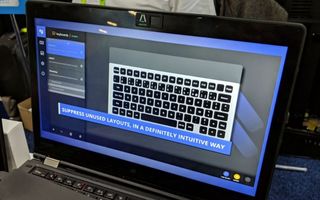This Strange E Ink Gadget Could Revolutionize the Keyboard
The Lenovo Yoga Book C930 proved last year that the PC keyboard is primed for innovation. Now, a French startup is taking things to the next level.

Nemeio is an e-ink keyboard that lets users change how each one of its 83 keys functions. With the flip of a switch, a user can adjust the keyboard interface to a new language layout (including emoji), or enable hotkeys when they're working in certain programs. Using the accompanying software, users simply drag and drop icons onto different keys in order to customize the keyboard for different applications.
The Nemeio plugs into your Windows or Mac PC via a USB cable, or you can connect wirelessly over Bluetooth if you want to use it on another smart device, like a TV. The battery should last about a day, and the keyboard's USB-C port enables fast charging.

At CES, Nemeio demonstrated the keyboard switching from a standard French language layout to a custom layout for Photoshop. The keyboard worked seamlessly, transforming the shortcut keys into photo editing tools, like crop, resize and paintbrush. Another keyboard layout changed the toolbar keys to application icons, like Skype, Facebook and Chrome. My favorite function replaced letters with emoji.

The concept is great, but the execution — at least, for now — leaves a lot to be desired. The biggest problem is the typing experience. Nemeio's clear plastic keys require far too much pressure to depress, and they didn't always register correctly. I wasn't able to take a typing test, but I'd guess that my words-per-minute count was less than half of what I typically type. Keep in mind, the product on display at CES was a prototype.

The Nemeio E Ink Keyboard is expected to ship in the summer of this year. The company didn't provide a more specific time frame or official pricing, but it's expected to cost between $300 and $500.
Credit: Laptop Mag
Stay in the know with Laptop Mag
Get our in-depth reviews, helpful tips, great deals, and the biggest news stories delivered to your inbox.
Phillip Tracy is the assistant managing editor at Laptop Mag where he reviews laptops, phones and other gadgets while covering the latest industry news. After graduating with a journalism degree from the University of Texas at Austin, Phillip became a tech reporter at the Daily Dot. There, he wrote reviews for a range of gadgets and covered everything from social media trends to cybersecurity. Prior to that, he wrote for RCR Wireless News covering 5G and IoT. When he's not tinkering with devices, you can find Phillip playing video games, reading, traveling or watching soccer.

